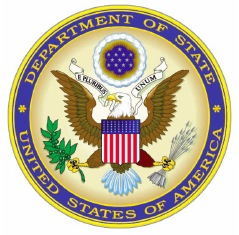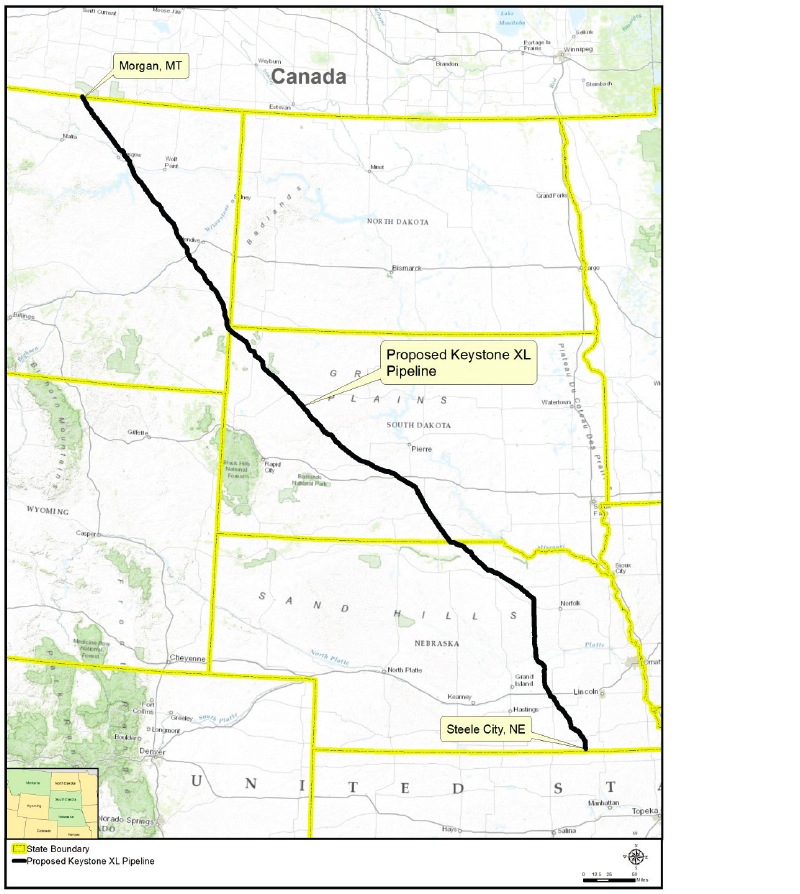UNITED STATES DEPARTMENT OF STATE
Executive Summary
ES 1.0: Overview of the Review Process
 The Keystone XL Pipeline (the proposed Project) is a proposed 875-mile pipeline project that would extend from Morgan, Montana, to Steele City, Nebraska. The pipeline would allow delivery of up to 830,000 barrels per day (bpd) of crude oil from the Western Canadian Sedimentary Basin (WCSB) in Canada and the Bakken Shale Formation in the United States to Steele City, Nebraska, for onward delivery to refineries in the Gulf Coast area (see Figure ES-1). TransCanada Keystone Pipeline, LP (Keystone) has applied for a Presidential Permit that, if granted, would authorize the proposed pipeline to cross the United States-Canadian border at Morgan, Montana.
The Keystone XL Pipeline (the proposed Project) is a proposed 875-mile pipeline project that would extend from Morgan, Montana, to Steele City, Nebraska. The pipeline would allow delivery of up to 830,000 barrels per day (bpd) of crude oil from the Western Canadian Sedimentary Basin (WCSB) in Canada and the Bakken Shale Formation in the United States to Steele City, Nebraska, for onward delivery to refineries in the Gulf Coast area (see Figure ES-1). TransCanada Keystone Pipeline, LP (Keystone) has applied for a Presidential Permit that, if granted, would authorize the proposed pipeline to cross the United States-Canadian border at Morgan, Montana.
The proposed route differs from the route analyzed in the 2011 Final Environmental Impact Statement (2011 Final EIS) in that it would avoid the environmentally sensitive Nebraska Department of Environmental Quality (NDEQ)-identified Sand Hills Region and no longer includes a southern segment from Cushing, Oklahoma, to the Gulf Coast area.
The U.S. Department of State (the Department) prepared this Final Supplemental Environmental Impact Statement (the Supplemental EIS) to assess the potential impacts associated with the proposed Project and its alternatives. The Supplemental EIS takes into consideration over 400,000 comments received during the scoping period and 1.5 million comments received on the Draft Supplemental EIS issued in March 2013. Notable changes since the Draft Supplemental EIS include:
Expanded analysis of potential oil releases;
- Expanded climate change analysis;
- Updated oil market analysis incorporating new economic modeling; and
- Expanded analysis of rail transport as part of the No Action Alternative scenarios.
E.S. 1.1: Presidential Permit Process
For proposed petroleum pipelines that cross international borders of the United States, the President, through Executive Order (EO) 13337, directs the Secretary of State to decide whether a project serves the national interest before granting a Presidential Permit.
To make this decision (i.e., the National Interest Determination), the Secretary of State, through the Department, considers many factors, including energy security; environmental, cultural, and economic impacts; foreign policy; and compliance with relevant state and federal regulations. This Supplemental EIS was produced consistent with the National Environmental Policy Act (NEPA) and will help inform that determination. Before making such a decision, the Department also asks for the views of eight federal agencies identified in EO 13337: the Departments of Energy, Defense, Transportation, Homeland Security, Justice, Interior, and Commerce, as well as the U.S. Environmental Protection Agency (USEPA).
If the proposed Project is determined to serve the national interest, it will be granted a Presidential Permit that authorizes the construction, connection, operation, and maintenance of the facilities at the border between the United States and Canada. The applicant would be required to abide by certain conditions listed in this Supplemental EIS and the Presidential Permit. The Department’s primary role is to make a National Interest Determination. Its jurisdiction does not include selection of specific pipeline routes within the United States.
In addition, the Department acts consistent with the National Historic Preservation Act (NHPA) and the Endangered Species Act (ESA) as part of its comprehensive NEPA consistent review.
E.S. 1.2: Background
Keystone’s first application for the Keystone XL pipeline was submitted on September 19, 2008, and a Final EIS was published on August 26, 2011. The route proposed included the same U.S.-Canada border crossing as the currently proposed Project but a different pipeline route in the United States. The 2011 Final EIS route traversed a substantial portion of the Sand Hills Region of Nebraska, as identified by the NDEQ. Moreover, the 2011 Final EIS route went from Montana to Steele City, Nebraska, and then from Cushing, Oklahoma, to the Gulf Coast area.
About the United States Department of State
www.state.gov
“Department Mission Statement: Shape and sustain a peaceful, prosperous, just, and democratic world and foster conditions for stability and progress for the benefit of the American people and people everywhere.”
Tags: Keystone Pipeline, State Department, United States Department of State







 RSS Feed
RSS Feed